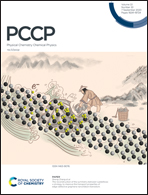Thermomechanical properties of zero thermal expansion materials from theory and experiments†
Abstract
Origin and composition dependence of the anisotropic thermomechanical properties are elucidated for Ba1−xSrxZn2Si2O7 (BZS) solid solutions. The high-temperature phase of BZS shows negative thermal expansion (NTE) along one crystallographic axis and highly anisotropic elastic properties characterized by X-ray diffraction experiments and simulations at the density functional theory level. Ab initio molecular dynamics simulations provide accurate predictions of the anisotropic thermal expansion in excellent agreement with experimental observations. The NTE considerably decreases with increasing Sr content x. This is connected with the composition dependence of the vibrational density of states (VDOS) and the anisotropic Grüneisen parameters. The VDOS shifts to higher frequencies between 0–5 THz due to substitution of Ba with Sr. In the same frequency range, vibrational modes contributing most to the NTE are found. In addition, phonon calculations using the quasi-harmonic approximation revealed that the NTE is mainly connected with deformation of four-membered rings formed by SiO4 and ZnO4 tetrahedra. The thermomechanical and vibrational properties obtained in this work provide the basis for future studies facilitating the targeted design of BZS solid solutions as zero or negative thermal expansion material.



 Please wait while we load your content...
Please wait while we load your content...